Humanity first achieved working cold fusion technology in the year 2000, jumpstarting an era of space exploration and colonization. This push to develop technology to live on places other than Earth was driven in part by urgency regarding Earth’s changing climate, which was being heated gradually by a buildup of CO2 in the atmosphere created as a byproduct of hydrocarbon-burning industry.
While the wealthy financed off-world habitation and gradually moved away, material conditions and climate change continued to worsen on Earth. As global temperatures increased, regions of Earth became inhabitable to humans and sea levels rose 300 meters, triggering a massive refugee crisis and the failure of coastal infrastructure around the globe. Systemic intervention was blocked again and again by corrupt power structures and corporations who had already left Earth and had no incentive to spend time and money mitigating the mess they had left behind. Many saw the disaster as a “natural” solution to overpopulation on Earth.
In 2138, this tension finally came to a breaking point between US colonies on Mars and the continental United States, beginning the Second American Civil War. Allies were drawn into either side of the conflict with wealthy parties of many different nations seeking to control spreading dissent on Earth, among transit workers on Luna, and in the mining colonies of the outer solar system. This culminated in orbital bombardment of several highly populated regions of the USA, Russia, and China.
Although off-world colonies had a lot of financial power, they were ultimately relatively fragile and dependent on lifelines of mined material from the outer planets and resources provided from Earth’s biosphere. Supply line choking to prominent stations in orbit of Earth, cloud colonies on Venus, and Martian surface colonies began to seriously strain the resources of the off-world powers. The nail in the coffin for the war was armed worker revolts directly on American Martian soil and Russo-Chinese Venusian skies. In 2143, the former United States and Russia had shattered into a collection of independently controlled territories scattered between 4 different planets, and the war was over.
In 2145, a United Nations summit met on Earth to address the state of human space after the war and the climate crisis on Earth. Luna and Jovia were declared independent autonomous polities and the use of hydrocarbon fuels on Earth was almost universally banned.
Gene therapy is genetic editing that can be done to post-natal human body. It has broad medical applications and is used variously to treat cancer, autoimmune disorders, allergies, microgravity body degeneration, genetic diseases, and more. It is most effective at treating issues related to "soft" or actively growing tissues, but cannot significantly change adult bone and body structure. It is typically administered through a subdermal injection regiment. A small percentage of patients have severe immune reactions to these injections, or other poorly understood intolerances to the treatment that make gene therapy impossible or ineffective.
Off-model GMH typically go through corrective gene therapy in their childhood, which can help alleviate some of their worst potential health problems, but this rarely makes them on-model.
Gene therapy is often administered in conjunction with lab grown limb replacements or augmentations to decrease rejection rates. It can also be used on its own for minor cosmetic changes; such as hair, skin, or eye color; with varying success rates.
DNA can be taken from a human patient and used to grow an organ culture over bio-matrix scaffolding. This allows custom replacement organs to be manufactured for virtually any part of the human body, including bones and muscles, sheets of skin, internal viscera, and entire working limbs. These genetically compatible organs can be implanted in and grafted to patients with a greatly reduced chance of rejection compared to donor organs, but can take months grow properly, and thus may not be suitable for urgent medical situations.
Experimentation has been done for replacing nervous tissue in patients with brain lesions and spinal cord injuries. These have had mixed success, mostly in cases related to the spinal cord and restoring some mobility to patients with paralysis.
Some biomodders commission custom grown limb replacements or implants (such as tails, horns, furred skin, non-functional wings) but these have to be grown with a modified version of the client's genome and have much higher rates of rejection. These modded organ culture implants are generally quite expensive, in addition to the added risks.
Custom sets of reproductive organs can be manufactured for patients undergoing sexual reassignment surgery, allowing patients greater control over their fertility and role in conception. Gonads with modified gametic genetics can also be manufactured for patients seeking to alter the sex ratios of their offspring and increase fertility, such as in cases of XY couples of XX couples seeking to conceive a child.
Artificial wombs were originally developed by GMO pet manufacturers, and were later adopted by corporations manufacturing “company clades” of GMH. This allowed them to produce large quantities of new humans without needing to recruit human surrogates to carry those pregnancies. In the modern day it is generally illegal to use an artificial womb to mass produce humans, but natal labs will still often use them to gestate designer babies for couples unable or unwilling to carry a pregnancy, couples with incompatible gametes, or couples commissioning a GMH baby that would be physically risky to carry in utero.
After WW3, the genetech industry faced a large wave of public scrutiny and calls for regulation on more extreme designer baby body types and “company” GMH. Company GMH were clades created specifically for the private labor market, such as tailed spacers. Although these clades were generally not forced into labor on paper, in practice they were often financially and institutionally pressured into preferred private labor positions, or designed with bodies that made it inconvenient to work in fields outside those intended by investors. In modern times company GMH clades are nigh-universally banned under criticisms of being modern slavery; but creation of clades for civic or scientific projects or designer baby marketing campaigns remain controversially less regulated.
As part of the post-WW3 scrutiny, a set of legal guidelines for GMH bodies was introduced by international human rights organizations, and acknowledged by the UN. These guidelines are:
GMH who do not fall into these guidelines are considered off-model, and the parties responsible for the undesirable result can face legal consequences. Severity of the penalty depends on the degree of intent and negligence, meaning labs that can prove that the off-model results were a result of nurture, or unforeseeable accidents usually only walk away with a slap on the wrist and minor fines.
These rules also apply specifically to natal labs and genetic scientists designing GMO humans in laboratories from scratch; and not to adult humans consenting to body modification. Laws about the extent to which biomodders are permitted to alter themselves with surgery, lab grown limbs, and cosmetic gene therapy vary regionally.
Although public perception of human genetic alteration has shifted significantly towards blasé acceptance in the couple hundred years since the first GMH was created, the laws and morality of pre-natally changing the human body remain hotly debated.
Supporters consider GMH creation morally allowable because no human consents to being born, so being born with six legs isn’t an offense to a fertilized egg any more than being born with the regular amount. Detractors cite the fact that changing a baby from the genetic default opens them up to possible discrimination and poor treatment wildtype babies do not face, and potentially increases the cost and failure rate of their medical care, as unforeseen medical issues later in a GMH’s life aren’t uncommon. There’s also concern from many activists about the interaction of GMHs and capitalism, where the phenomenon is seen as a result of late 21st century capitalism shifting the Overton window on human cloning for its own financial benefit at the expense of human welfare, and this kind of designer baby is only seen as acceptable in modern times because of the existence of other humans who have already been altered in this way.
Even GMH themselves tend to have pretty varied views on the legality and morality of making more GMHs. Although the continued existence of reproductively stable clades is considered a non-issue outside of extremist elimination groups; the subject is complicated by the fact some clades, like androtherians, are far too diverse for most members to have healthy, genetically similar children without natal lab intervention. Children between two members of different clades essentially require a lab.
Social treatment of GMH varies wildly depending on their clade and class history.
Many androtherians are descendants of historically wealthier families, having been created mostly as designer babies or novelties. The material conditions for modern androtherians are quite variable, but they are often assumed to be upper middle class. They tend to be an insular group in the modern day, seeking other androtherians as partners but frequently designing their offspring to have unique traits that they personally find interesting. Androtherians are still a popular choice for typ parents seeking designer babies, and there is a cultural divide between the androtherian children of typs (sometimes called "typ orphans") and androtherian children of androtherians (sometimes called "pedigree kids"). The former may feel bitter about being born outside the community of the latter, or actively seek it as an adult.
Unique GMH are a modern status symbol, and are rarely not from money. The typical presumption is that the more unusual the design, the more money went into making them, and the weirder and more distant their parents are. Unique GMH are sometimes sarcastically referred to as the "ultimate designer pet." They frequently have difficulty finding partners, for a number of reasons. They are definitionally not in the same reproductive group as any other humans, often have appearances that are striking but not conventionally attractive, and many are socially awkward as a result of their position. Typs dating unique GMH are often assumed to be gold diggers or trophy partners.
Tailed spacers have a long and complex history as company GMH originally created as indentured microgravity labor, and a unique flavor of bigotry gets directed at them by other humans. Tailers are simultaneously presumed to be the best choice for any microgravity job, and resented for "taking" those jobs from other humans. Tailers working outside of the aerospace or on the ground may be especially poorly treated, as they are seen as rejecting a "free career," and inferior to other human workers on the ground. Other stereotypes paint tailers as conspiratorial, duplicitous, demanding, and willing to throw anyone under the bus for other members of their clade. This is partly a reaction to tailer labor rights movements, community solidarity, and their perceived "takeover" of Luna post-WWIII.
Cetasers have some similar problems to tailed spacers when seeking life outside of their perceived "built-in" jobs. Most of their communities live in coastal regions of Earth, and they are fairly rare elsewhere. Their bodies are rather awkward out of water and accommodations for their shape are rare off Earth. Other humans tend to perceive them as clumsy, unkempt, "wild," or innately in touch with Earth and the natural world. Extremely exaggerated rumors circulate about them being able to communicate with whales and dolphins.
Magpie Bridgers avoided some of the "built-in job" resentment that tailers and Cetasers get, mostly because the project they were designed for is stuck in development hell. Within their home country they are seen as having been a waste of government money on a frivolous utopia project when there were much more prescient problems that could have used the attention; outside China they are mostly seen as an oddity or just another bird-winged GMH. They find themselves a target of Sinophobia more often than GMH-related discrimination.
Off-model GMH face compound discrimination, as they are often visibly "ugly" or "imperfect," and many have disabilities related to their genetic status. They make an easy target for run-of-the-mill bullies looking for someone to torment, and may face employment discrimination as a result of their disabilities. Some off-model GMH, like Gillie, will choose to selectively conceal their off-model traits in an effort to avoid assholes.
Most of the discrimination GMH face comes from fellow humans, but skimmer avians are more likely than any of the other aliens to harass GMHs. The reason is a little esoteric: There’s a cluster of old skimmer religions that states in doctrine that there was originally one avian species, and then after a fall from grace they were split into multiple imperfect species. This myth has historically been used to justify colonialism and treatment of the other members of their genus as lesser beings. The story, whether or not it's interpreted literally, still has a lot of cultural power. So, in the eyes of many avians, humans are falling from grace in real time– enacting the beginning of a mythic history that has created a lot of strife on their planet. Skimmer avians tend to see GMH either as a huge mistake that will result in interspecies war, or as a place to project their racist anger at other avians that won’t get them in trouble (with other avians).
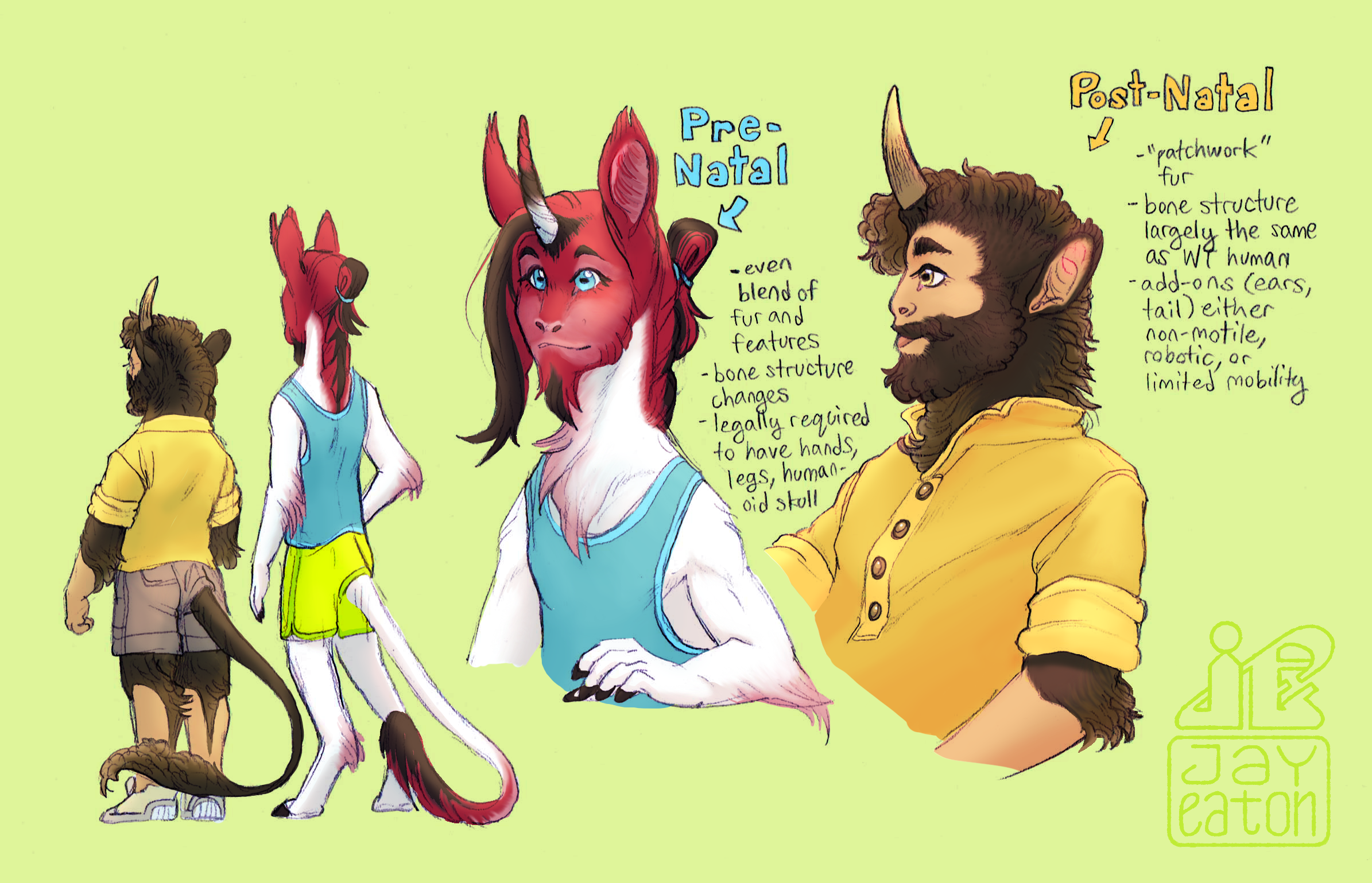
"GMH" generally refers to humans that were altered pre-natally. Biomodders take up the process as adults, which eliminates most of the moral ambiguity, as they can consent to the changes and understand the potential complications. It's close in spirit to extreme body modification.
But as adults with a fixed body frame, there are limits to what can be modded– most plastic surgeons are only willing to culture and swap out soft tissue, and gene therapy is usually required during the healing process for grafts to be accepted. Muscular additions are a bit of a crapshoot because there’s no telling how well the brain will adapt to and learn to control new muscle tissue.
The feelings designer GMH have about typ biomodders are often slightly hostile. While a GMH doesn’t elect to have the body they do and can be subject to medical problems and discrimination for it, a biomodder opts into almost the same situation for few reasons other than aesthetic preference. Some typ biomodders also very much want to be considered GMH, or attempt to "pass" as GMH in order to join their communities, which is considered rude at best. This is an over-reported phenomenon, though— most biomodders are simply seeking to inhabit a body that they enjoy more than the one they started with.
Some GMH also undergo biomod procedures, though most often it's off-model GMH looking to appear more "normal," or other GMH wanting to have traits closer to typ beauty standards. Extravagant and statement biomodding is overall about as common in GMH as it is in typs.
Humans evolved as a bisex species, and later gained the technology to modify their anatomy, bringing into existence unisex humans. This has intimately shaped the modern human social landscape.
Most human societies medically recognize four sexes of humans: female, unisex/cosex, male, and intersex. While medical professionals and sociologists generally agree it is more accurate to describe sexes as existing on a continuum, these terms conveniently lump together groups of humans into demographics based on shared anatomical features and gamete production. When it comes to gender, the social roles, terminology, and traits expected of different sexes; human societies are much more divided.
In much of human society, particularly spacer cultures, social gender is legally recognized as a trinary of women, enbies, and men. Enbies (a.k.a. nonbinary) humans are the smallest category, representing about 10% of Jovians, 8% of the Martian states, 39% of Venusians, 1% of the Terran nations, and 84% of Lunarians. Nations with a higher population of tailers tend to have a comparatively greater demographic of nonbinary humans. Many enby humans are either born unisex or transition to unisex later in life, and in some conservative polities, this is a mandatory condition before they can be legally recognized as a nonbinary gender. Even more conservative cultures may only recognize two sex-linked genders, and will classify unisex individuals as either men or women based on how much importance is placed on matrilineal vs patrilineal inheritance, or on an individual basis of their gender presentation.
While “nonbinary gender” is often used in cultural discussions as a catch-all for humans who are not exclusively men or women; in practice enby humans are generally given their own melange of cultural expectations and stereotypes, and may face social backlash from performing the gendered traits expected of them “incorrectly,” just as men and women do. Fluidity between more than one gender in the trinary (such as frequently changing one’s preferred pronouns and terminology, and fluctuating between extremes of gendered presentation and behavior) usually receives the harshest social backlash and may be viewed by others as selfishly inconvenient, attention seeking, or a sign of mental instability.
Most spacer cultures recognize gender and sex as separate but related categories, with humans being assigned one sex and gender at birth, but being free to transition to a different sex or gender later in life. In nations with unrestricted access to surgical sex reassignment and a neutral attitude towards social gender transition, about 7% of the population will undergo sexual transition at some point in their life, with 8% choosing to officially gender transition. That latter demographic only reflects changes to government documentation, such as passports and IDs, and the total percentage of people who socially transition at some point in their lives (including those who transition back, or transition multiple times) is estimated to be larger.
Some liberal ideologies believe that it is beneficial to classify infants as enby and at birth and let them choose a gender when they are old enough to understand the categories, critics say this is redundant with assigning them any other gender at birth. Other liberals seek to abolish sex as a category and only classify individuals by gender outside of medical contexts, critics say that sex is simply too relevant to daily life and the structure of human families to ignore outside the doctor’s office.
Some conservative ideologies seek to unite gender and sex into a single category based on the current physical sexual traits of the individual— i.e., someone who produces both sperm and eggs is enby, someone who only produces sperm is a man, and someone who only produces eggs is a woman. Critics point out that these physical categories are frequently just as ambiguous as social gender; and fail to reflect a lived reality for people who can not (or will not) undergo surgical sex reassignment, but live their daily lives as a “conflicting” gender. Some conservatives argue that humans should not be unisex or non-binary, and existing as an exclusively bisex species with sex-linked gender is healthier for human society. Critics point out that unisex humans in societies that do not stigmatize their existence don’t experience significantly higher rates of physical and mental health problems than bisex humans, and that humans with non-bisex characteristics and nonbinary genders have existed well before the 24th century.

While flags most commonly represent their polities, humans sometimes also use flags to represent gender and sexual minorities. The most common unisex flag variant features a purple circle with a line through the center over a white field. The character is the alchemical symbol for the body, and reflects the circle element of classical male and female symbols. The purple represents unisex individuals who see themselves as a combination of male and female, and the white represents those who do not see themselves as either. The field of the unisex flag is sometimes changed to the pattern of other flags as a way to represent more specific identities.
In the 23rd century there was a proliferation of transhumanist unisex separatist clades, who were genetically unisex with no other significant differences from typ humans. The goals of these "unisep" groups (generally speaking) was to eliminate sexism from human society through eugenic selection of unisex individuals over bisex individuals. Many were classified as cults or terrorist organizations by their endemic governments. The vast majority of these groups fell apart do to a combination of having small genepools very reliant on outsourcing and recruiting to avoid inbreeding, inbreeding, cult mentality, infighting, and competing standards for unisex genes and unisex anatomy. Individuals from different unisep groups were usually genetically incompatible.
The largest surviving unisep group is the "One Shape" organization, whose longevity is attributed to their connections to old money, politicians, and their emphasis on conversion over elimination. One Shape is based in the Socialist Republic of Mars but they have a significant presence elsewhere, particularly Earth. They are known for "missionary work" where they push for legal support of unisex and nonbinary identity in conservative Earth polities, recruit typ humans to transition to unisex (specifically, their personal genetic brand: XOXO), and encourage unisex people to have unisex children. One Shape's frequent equivocation of all unisex humans with their clade as shaped Terran perspectives on unisex people in general, causing some to assume all unisex humans are members of One Shape.
Public opinion is generally suspicious of One Shape, and they are known for supporting eugenic policies and using cult-like member retention tactics. They are also known to publicly disapprove of the continued production of any other GMH (including the children of genetically incompatible humans), and of surgically unisex humans who retain bisex gametes. A popular conspiracy theory assumes that One Shape was a cultural implant by the BFGC to make humans more like bug ferrets, but there is no credible evidence to support this connection.
The most commonly spoken languages in human space are English, Mandarin Chinese, Portuguese, and Hindi. The story mostly takes place in Anglophone space, and there are a couple of regional variants.
Jovian English is the dialect of English spoken in the outer solar system. It is a descendant of Martian English and the two are very similar, although accent, slang, and word usage varies enough to make them distinct.
Jovian English has three sets of singular third person pronouns. She/her/hers for assumed female humans; he/him/his for assumed male humans; and they/them/theirs; which is used for humans of unknown gender, assumed nonbinary or unisex humans, or aliens (who regardless of sex comparisons, are usually considered different genders than human male and female). The extremely frequent use of they as a singular pronoun has led to the common use of a slang word "th'all," a contraction of "they all," meaning the same thing as a plural they. Its possessive form is th'all's.
Martian English more closely resembles the American English it descended from, and is spoken in the two countries on the surface of Mars that used to be U.S. States. There are other Anglophone regions of Mars that speak English dialects closer to the countries that their regions are affiliated with, but they tend to be influenced by Martian English because there is much greater lag between Earth than Mars locals.
Martian English speakers refer to some sophonts and technology differently than Jovians. Centaurs are called tigerhorses, wormhole generators are called gates, and bug ferrets are called gateworms.
Martian English shares the "she" and "he" of Jovian English, but disagrees on the neutral singular. "They" is not commonly used as a singular pronoun outside of cases of a hypothetical human or human of unknown gender, for assumed non-binary or unisex humans xe/xem/xers is preferred (x pronounced as a "Z"). Aliens, who are also assumed non-gendered, get their own singular pronoun group: xey/xem/xeirs.
"X" pronouns are fairly popular in tailed spacer communities and can be found in several different forms there, including both the Martian variants, xe/xim/xis, and xe/xer/xers.
American Sign Language (ASL) is a visual-manual language originating from the USA, a former nation of North America, from which it spread as dialects to other nations in Earth and space. It is a descendant of French Sign Language and although it commonly uses English loan words, it is not the same language. Sign languages that originated from different Anglophone locations on Earth, such as British Sign Language and Australian Sign Language, are not mutually intelligible with ASL.
Like most human sign languages, it is intrinsically tied to Deaf culture and is most commonly found flourishing in areas with Deaf schools and colleges. The largest communities of ASL users are found on North America on Earth, around institutions such as the North American Republic's College for the Deaf.
The cultural descendants of the USA on Mars (the SRM and MFS) and Jovia also speak dialects of ASL, sometimes referred to as M-ASL or J-ASL, but have much smaller, more scattered Deaf communities and fewer schools. This is in part due to how SRM, MFS, and Jovian medical care prioritizes auditory implants and gene therapy as a solution to hearing loss over sign language acquisition; and generally practices oralism, which is the prioritization of oral language acquisition over alternatives. Most of their hearing-disabled populations are older humans not seeking treatment, or unusual medical cases where implants and gene therapy aren't effective. As a result, the SRM, the MFS, and Jovia have not formed strong Deaf cultural communities, and have higher social isolation rates for those with hearing disabilities.
The subject of treatment and oralism focus verses cultural and manualism focus is highly controversial within Deaf culture and among medical professionals, and many young Deaf Jovians and Martian Staters end up leaving their birth polities to live closer to other signers.
"Spacer" is a generic English term for a person living off of a planet, though, in practice, it's extremely relative. Anglophones on Earth use it to refer to anyone who lives off of Earth. On Mars they use it to refer to people living on moons, ships, and space stations. On Luna and other moons they use it to refer to people living in ships and space stations. People living in ships and space stations... are one of the only groups to self-identify as spacers. So folks from Nexus Jovia like Talita, Idrisah, and Gillie would consider themselves spacers.
Ironically, though tailed spacers derive their clade name from this term, a tailed spacer living on a planet (like Shyam) would not be considered a spacer. The nickname for tailed spacers is the portmanteau "tailer" partly because it removes ambiguity.
Predating genetically modified humans was a GMO pet craze. First popularized by Chinese genetic companies, designer pets such as neosaurs, "dragons," toy versions of large wild animals, chimeras, and more spread like wildfire to other first world nations. Competing gene labs popped up like wildfire looking for a slice of the market, subsidized by local governments looking to slow down the influx of imported foreign GMOs.
One of the chimera style designer pets popularized in North America was chabbits (also known Easter bunnies, skvaders, or boultry) which came in a variety of different body types imitating domestic rabbit and chicken breeds. Chabbits are capable of interbreeding, and does of different varieties each laid a distinct egg color and pattern. They are simple hexapod GMOs with one rib cage, two upper limb girdles, and a lower pelvis. Their winged midlimbs are not functional for flight. The chabbit upper body has fur, and the lower body has feather tracts.
Chabbits later became popular as a commercial livestock in space habitats.
Giant house cats are a large version of an ordinary house cat, usually standing between 70 to 90 centimeters tall at the shoulder. They typically have duller claws and a milder disposition than typical house cats. They are notorious for mauling incidents and "behavioral issues," which are more accurately described as regular cat behaviors in an animal large enough to do severe damage when upset.
They come in a variety of typical domestic cat coat colors, atypical and "wildcat" colors (such as black and tan, tiger stripes, leopard spots), and fantasy colors (such as blue, green, iridescent).
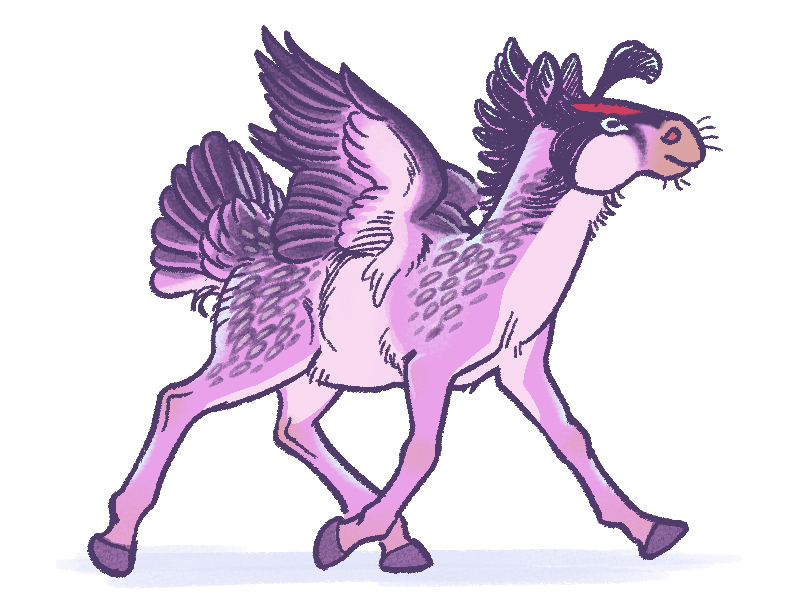
Quailicorns are from a long running Jovian interactive children’s media property of the same name, which is about little colorful winged horses that travel through time and help humans from different time periods solve technological problems. The original run of the property was released in conjunction with a breed of GMO pet resembling the main characters. Although the media property is still quite popular, the pets are rare now. Since they are miniature horses, they have higher space requirements than most spacers can afford; and their lack of flight, speech, or time travel abilities meant they were met with lukewarm reception by children. However, there is still a small but dedicated community of quailicorn breeders on Mars.
Yeast and algae are the two major staples of spacer human diets, providing energy efficient sources of protein, lipids, and carbohydrates.
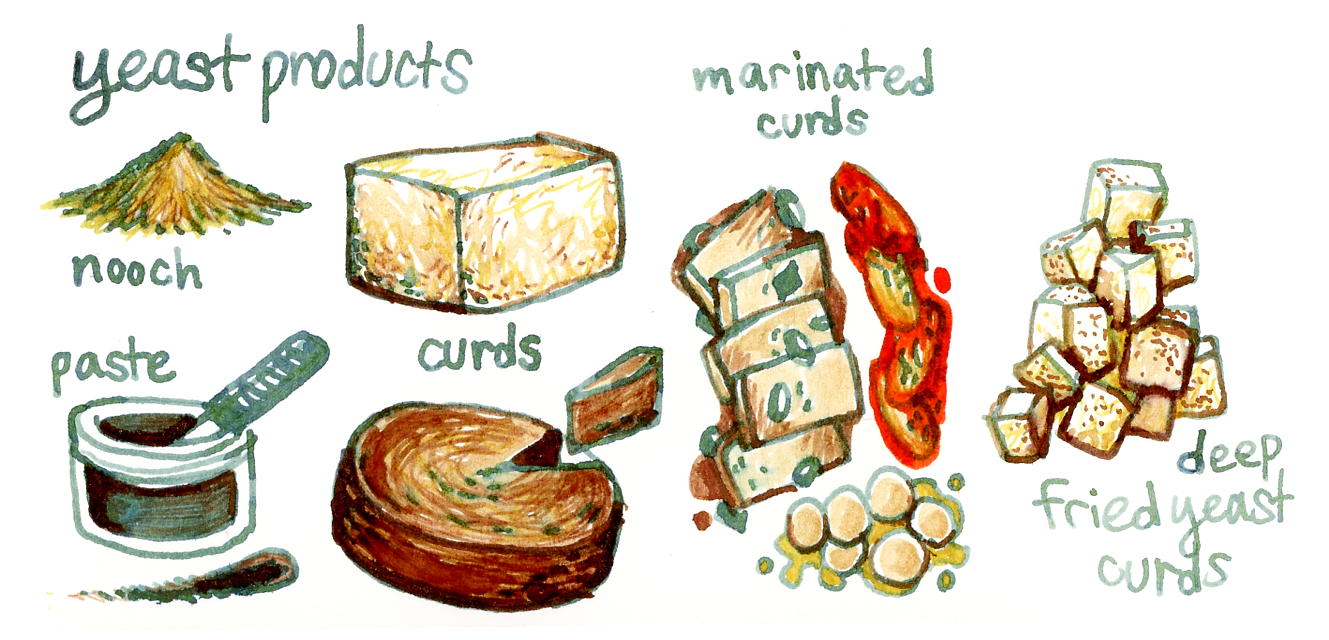
Yeast is never eaten raw but is found in a variety of processed forms, the most common of which are powders, pastes, and curds. Powders and pastes tend to be most strongly flavored. Some are given flavored additives, or salt-fermented for an even stronger taste. The powder forms (often called nooch) tend to taste cheesy, and the pastes most commonly resemble yeast extracts like Vegemite or Marmite in flavor. Yeast curd is a tofu-like substance with a faint mushroom flavor and high protein content. It’s most popular marinated or fried, and comes in a variety of firmnesses from silken to jerky.
“Trained” yeast is genetically modified to produce a specific desired biological compound or set of compounds, and is widely used in the manufacture of synthetic flavors, dairy products, proteins, enzymes, and more.
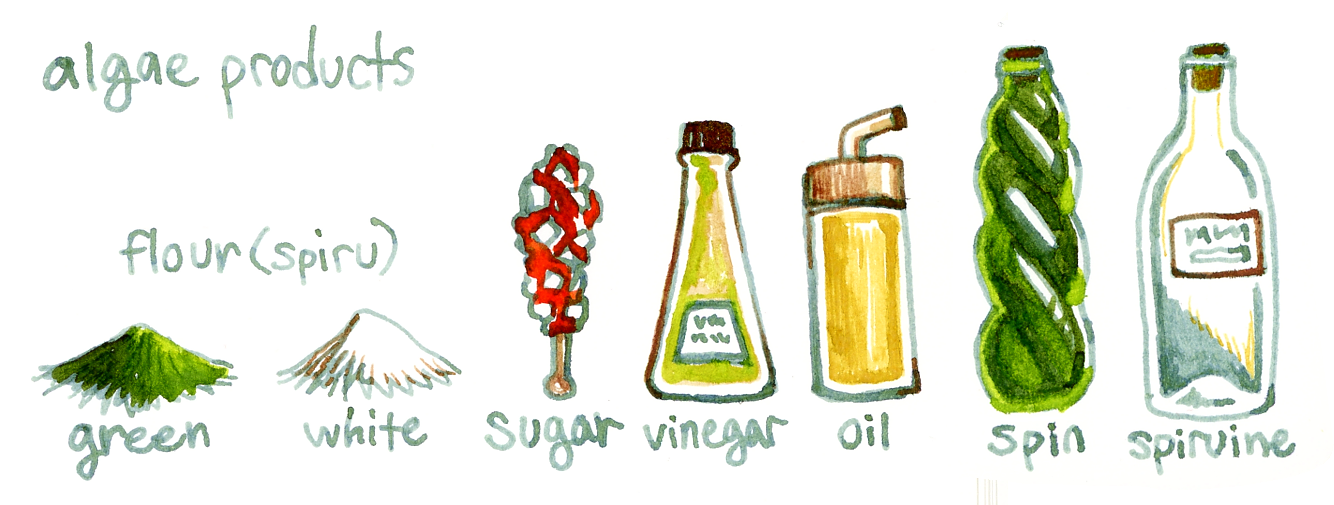
Algae eaten by spacers is mostly genetically modified chlorophytes such as Botryococcus braunii and the Chlorella genus, and the most commonly cultivated cyanobacteria is Arthrospira platensis (spirulina). These are used to produce a wide variety of refined food products, including flour, sugar, agar, oil, and vitamins. When fermented by yeast, vinegar and spirits can be produced from algae products as well.
Algae flour (sometimes called spira) comes in two main forms, green and white. Green flour is unrefined algae powder and can have a very strong grassy taste. White flour is refined to remove most of the compounds in the powder that aren’t starch, and it can be used to make dough. Some white algae flour has synthetic gluten added to give it an elasticity similar to wheat flour, but it is more rare than agar being added as a stabilizing agent. Leavened dough with agar tends to have a more brittle, crumbly structure than glutenous dough.
Fried, baked, or steamed spira dough dumplings with yeast paste and other fillings inside are an iconic spacer food with many regional variations. Jovia’s variation are a steamed rolled bun that uses enough green spira to make the dough green, and has yeast paste painted on the rolled side. Slices of curd are sometimes laid on top with a yellow cherry tomato or egg yolk in the center to make the bun resemble a wheel, or a cross section of a habitat cylinder. These are known as Jovian wheels and they are commonly eaten on Jovian Independence Day.
Spin is a kind of spirulina-based hard liquor produced on Mars, known for its bright green color and strong, controversial flavor. It is traditionally not sweet, but sweetened versions and cocktails are more commonly enjoyed by those less used to the stuff. Clear, relatively flavorless hard-proof liquor produced from algae is generally called spiruine.
On Earth, yeast products have been gaining popularity but algal farming remains relatively rare. Soil farming is the cheaper option when air and light are free.
Hydroponic agriculture is the next step up in complexity for spacer diets. A wide variety of vegetables, seeds, pulses, herbs, leafy greens, mushrooms, and berries are grown in zero gravity farms around Nexus Jovia and in greenhouse complexes on Mars and Luna. Tree and grain farms are more common on Mars and other large celestial bodies, while in space station cities like Jovia they are more space inefficient and less compatible with hydroponics. Tree fruits, nuts, and grains tend to be imported to space stations more often than they are locally produced.
In weightless hydroponics, some crop plants are bred to grow continuously from the apical meristem and harvested just underneath it, resulting in high production with less crop turnover. In vines like tomatoes and beans, the older portion of the vine is wound up like rope as the meristem of the plant continues to grow towards of the lights. In stalk plants like lettuce and Brassicas, the crops are turned over when the cane of the plant grows too long and close to the light.
Potatoes and pulses are the most common staple carbohydrates for spacers after algae.
The vast majority of mass production farming in space habitats is aquaponic, but most colonies with permanent residents and large populations have soil areas with plantings. Trees are generally not planted in ground on small space stations because of the destructive potential of their roots, though some hydroponic orchards, dwarf varieties, and container-tolerant trees may be acceptable. Large cylinder habitats usually have deep enough soil sections to plant trees without issue, though soil sections usually have a bottom barrier that is monitored for root and water infiltration.
Many park spaces in space habitats are dual-purpose, meaning they serve as part of the system’s agriculture as well as being recreation and relaxation areas. Fruit, nut, and sap trees, as well as crop bushes and fodder grasses can be found. Laws and regulations regarding public harvest tend to be incredibly strict, particularly with trees, as real wood is a valuable commodity off of Earth and wood poaching is a common problem. Materials and activities allowed within parks also tend to heavily regulated to avoid contamination and biosystems destruction, and most parks are enclosed with monitored entry points.
Animals in parks tend to be limited to invertebrates. Birds are sometimes introduced in parks with enclosed tops, as they are considered a hazard if they leave the park and fly into maintenance areas. Birds and flying insects usually have difficulty navigating the weightless center of centrifugal gravity habitats. Introduced rodents can be a major issue in larger parks.
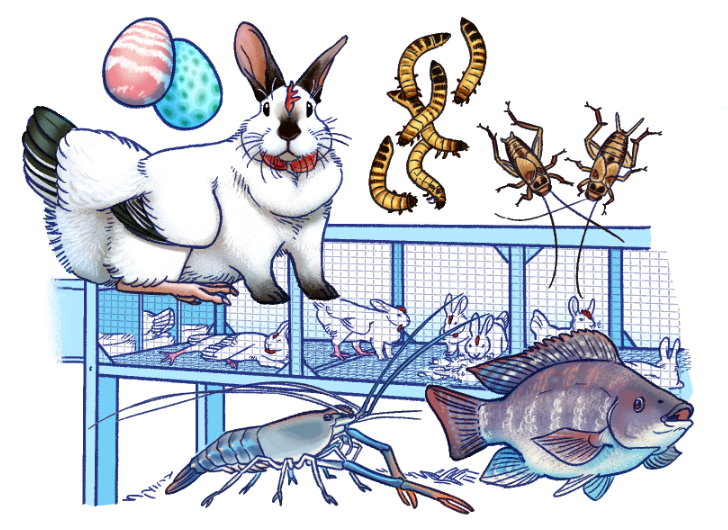
Entemophagy, while controversial in Terran cultures, is very common in spacer diets. Crickets, mealworms, and soldier flies are the most commonly raised insects, and are often enjoyed deep fried till crispy with strong spices. Some larger GMO insect varieties are also kept that can be more easily gutted and shelled, like shrimp. The taste of these fillets is similar to crab or shrimp, but sweeter and grassier. Entotarianism, the practice of eating no animals other than insects and crustaceans, is fairly common in spacer cultures.
Freshwater prawns and other aquaponic livestock are commonly eaten as well, as these form the back end of most spacer farming operations. These are all freshwater animals, however. Saltwater livestock farming operations are rare off of Earth’s surface due to the corrosive effects of salt and their lack of synergy with other farming operations. Saltwater farming is beginning to find its way into Martian culture, but it’s still only expensive imports in Jovia.
Chabbit is the most popular vertebrate livestock animal with spacers. They are a sturdy hybrid, quieter than chickens and more sociable than rabbits, and produce eggs and meat on a completely vegetarian diet. In space stations, they can be used to produce agricultural waste products and cycle roughage back into fertilizer. Commercial breeds tend to be simple white or brown in appearance, but egg farmers still breed for eye catching eggs or a pleasing variety of patterns and colors. Most commercial chabbits are dual-purpose egg and meat breeds, but meat breeds are selected for larger breasts on the midlimbs and a thicker backstrap on the lower spine. Meat production is split between the byproduct of culling old layers and growing out excess roosters for slaughter. In Jovia, the most chabbit meat production and layer turnover happens during Spring Maintenance Week, which is followed by Easter Feast. Grilled, roasted, and stewed chabbit are popularly enjoyed during this holiday.
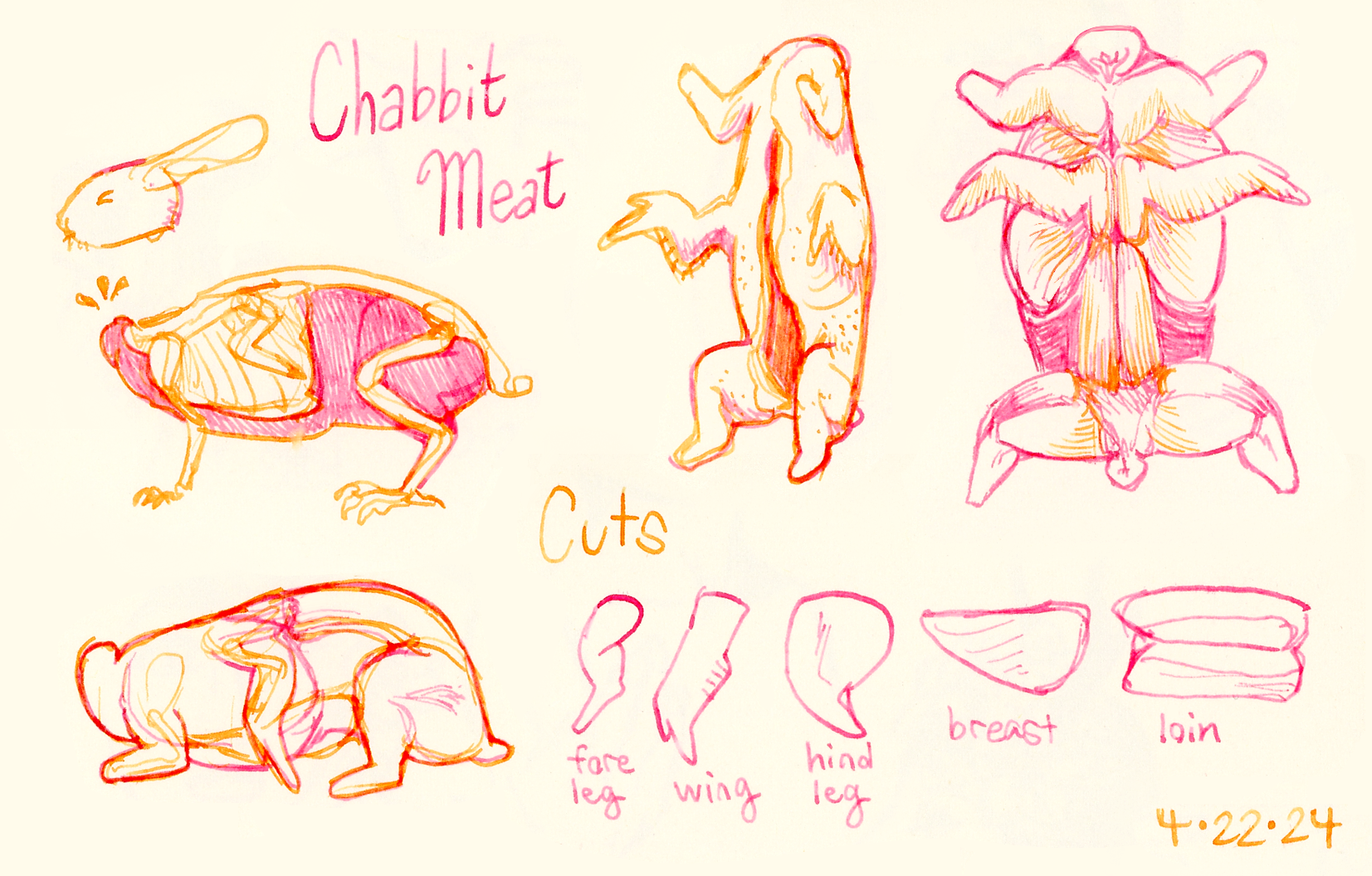
The second most common large livestock animal in spacer colonies are GMO omnivorous goats. With a diet more similar to a pig than an ordinary goat, they are generally prized for their compact build and ability to recycle waste products of all kinds back into meat, milk, leather, and fiber. The flavor of their meat and milk is much more mild than that of typical goats, being more comparable to those of cows or sheep. While animal dairy is generally more expensive in spacer cultures than tissue culture or synthetic milk and butter products, the most common available form of it is goat dairy.
Tissue culture meats are often seen as a kind of “immigrant food” by spacer human cultures, who statistically eat less meat overall than humans who grew up on Earth; favoring arthropods, eggs, yeast products, and aquaculture fish as protein sources. Meat from large terrestrial animals is often viewed by spacers as either a special holiday food, an unnecessary waste of resources, or barbaric and obsolete.
For exotic meats like cow and pig, tissue cultures are more affordable off-Earth in comparison to frozen imports. They are usually boneless and have a noticeably different texture than livestock meat, generally softer and more homogeneous. Their cost to produce varies depending on their “authenticity.” Sausage-like or simple muscular cultures are cheaper than locally produced livestock meat, while specific body structures or anything with bones are more expensive or at a comparable cost to livestock meat. Insect farming and aquaponics are cheaper than both options.
Tissue culture diary is fairly common and is cheaper to produce than goat dairy, though it is usually considered “lower quality” by spacer cultures than “real dairy,” despite little evidence of a difference. Access to “real” dairy via goats is considered a luxury of living in a larger space habitat capable of keeping them. Tissue culture egg products tend to be unpopular in comparison to chabbit eggs, since cultures produce a yolk fluid and albumen fluid rather than a structured egg, but they are usually available as a vegan alternative or for food printers.
Tissue cultures as an alternative to animal agriculture can be extremely efficient when established, but are subject to unique problems and are extremely vulnerable to temperature swings, introduced bacteria, chemical and pH fluctuations. A clean room system is required to mass produce tissue culture products. Animal agriculture for now has advantages in space that keep it competitive with tissue cultures, in that the environmental requirements of a livestock animal are identical to that of a human farmer. Large space stations usually maintain both livestock and tissue cultures, as having both provides redundancy in case of one system failing.
Glowing food items are a popular novelty item in human culture. The glow is produced by mixing the protein luciferin with the enzyme luciferase, the same two chemicals that cause glowing in the abdomens of fireflies and bioluminescent plankton. Glowing candy is traditionally enjoyed for Allnighter in Jovia, as well as shaved ice and drinks with glowing syrup.
Myla, short for mycellial lattice, is a product grown from the mycellium a bioengineered version of the common oyster mushroom (Pleurotus ostreatus). It is light, strong, flexible, and can be grown over a scaffold structure or inside a mold, giving it incredible shape versatility. It is fed with a sterilized slurry of algal byproducts, shredded plastic, compost, and human and animal waste.
Hard myla is a stiff, wood-like material. Because of the difficulty and inefficiencies of growing trees off-Earth, it is far more commonly used in construction than wood on Mars and in Jovia. Before use in construction, the mycellium are killed by exposing the myla material to vacuum and allowing the water to sublimate out.
Soft myla is a spongy material made from a similar strain of P. ostreatus, which is exposed to wet heat and pressure to kill the mycellium rather than vacuum. It comes in a variety of firmnesses and is used in the manufacture of soft flooring, sponges, insulation foam, mattresses, foam fabrics, paper, protective packaging, and more.
There is a viral dance craze in Runaway to the Stars "modern day" (approx. 2325), because what is society without a viral dance craze. It began on Martian social media and then spread to the rest of the human internet via the extranet social platform Megaforum.
It is called "The Whop."
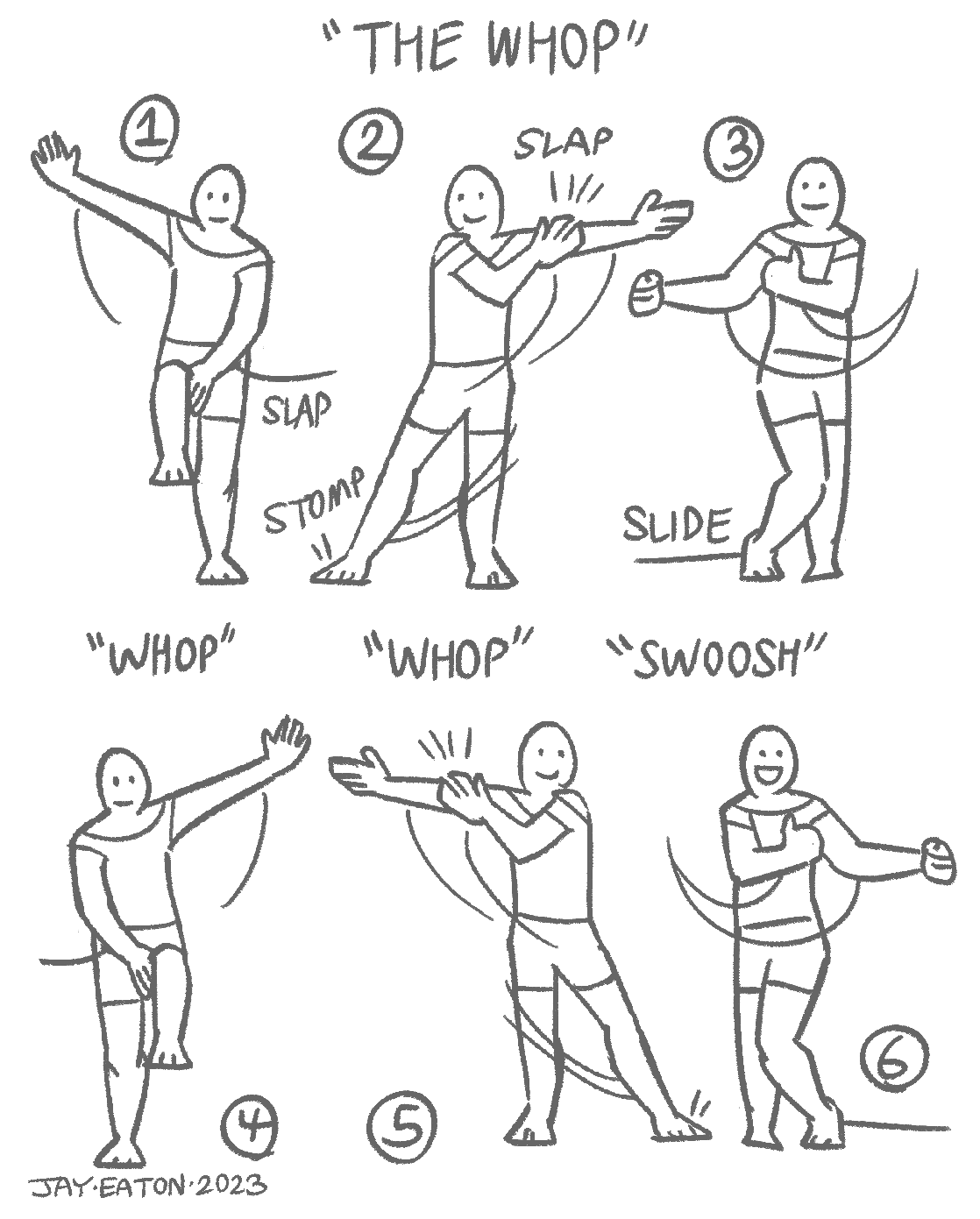
It takes some skill to whop quickly without losing your balance, and videos of skilled whoppers dancing in increasingly ridiculous and inconvenient locations has plagued the human internet for years now. It has a resurgence every time a new bubble of human space discovers and spreads it.
There is also a two-person version of The Whop:
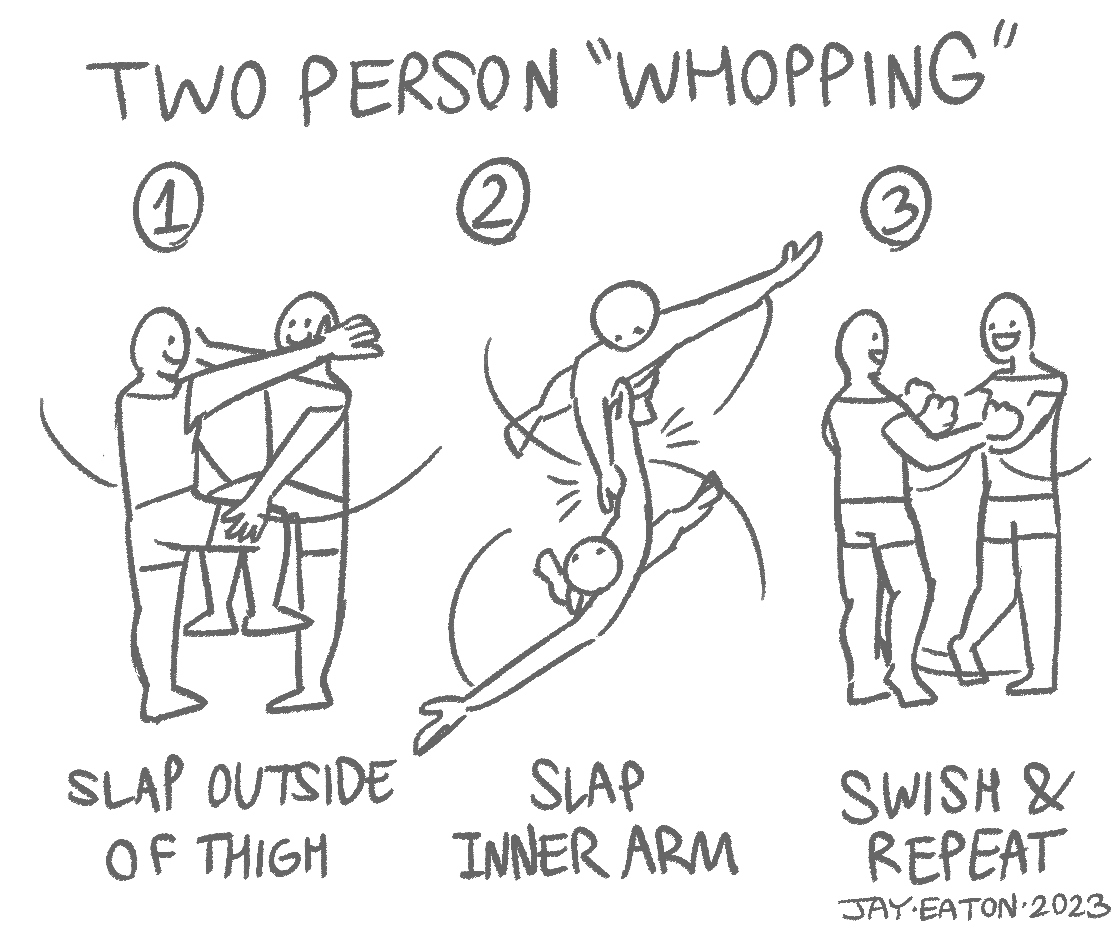
Two-person whopping is extremely popular among children, much to the dismay of their elders. If you don't pay attention and keep time with the other party, it's extremely easy to slap them square in the face. Video compilations of people getting injured while whopping abound. School nurses have seen many victims of the viral dance, sent in with bruises and bloodied noses after whopping too hard.